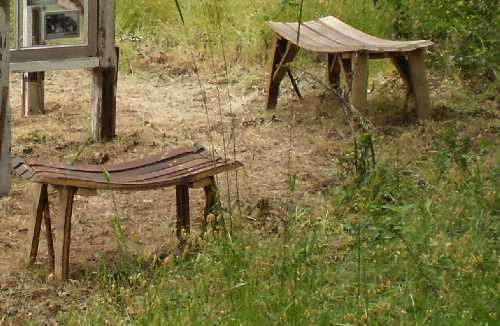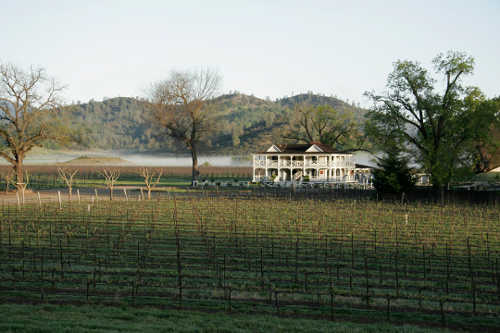
This pair of honey bees harvests nectar from a sunflower at the Leonardis Organics farm in Kelseyville, Calif. Photo by Esther Oertel.
I'll never forget the sheer delight I felt upon my first taste of honey. The sweet explosion of chewy stickiness contained in that piece of golden childhood honeycomb still resonates in my mind.
I’m not the first one to revel in this sweet made by bees. The human longing for honey goes back to prehistoric times, as revealed by a 10,000 year old cave drawing in Valencia, Spain that depicts two women using sticks to retrieve honey from wild hives.
The Egyptians are credited as being the first civilization to keep bees some 5,000 years ago. Not only did honey sweeten their cakes, it was an ingredient in all their medicines, was used in mummification processes, and Cleopatra is said to have made it central to her beauty regime.
The ancient Egyptians began the practice of keeping bees, but the ancient Romans perfected it. Being fond of sweet foods and beverages, honey was a key ingredient in many of their recipes. In fact, some say that honey was a fixture on Roman tables and was put on their food at every meal.
Honey provided another boon to Roman citizens. During the reign of Julius Caesar, it was acceptable to use honey instead of gold to pay taxes.
Honey was also cultivated in other ancient civilizations, such as China, where books were written about the art of beekeeping, and in Mesoamerica, where the Mayans used honey from the stingless bee native to that area.

Robert Landrum of RB Honey offers his locally-produced honey at many of the farmers' markets in Lake County, Calif. Photo by Esther Oertel.
Honey has significance in a variety of religions around the world. In Hinduism, honey is considered one of the five elixirs of immortality. Buddhist legend has it that honey brought by monkeys sustained Buddha while he retreated to the desert.
The Hebrew Bible is riddled with references to honey, including the famous phrase about milk and honey flowing in the Promised Land. In the Qu’ran, the holy book of Islam, the Prophet Mohammed recommends eating honey for health.
Honey has captivated the imagination – not to mention the taste buds – of humankind almost as long as we’ve been around.
A quick Internet search for the use of honey in world cuisines yielded recipes from Morocco, Thailand, Vietnam, China, Japan and Malaysia, all for chicken prepared with honey. Clearly, honey has worldwide appeal; in fact, it’s cultivated for culinary use in almost every country.
The sheer magnitude of honey varieties made from the nectar of specific plants is astounding. These can range from herbal plants, such as lavender and thyme, to flowers, such as clover and heather, to unique trees, such as eucalyptus and pine.
Honey made from the blossoms of various food plants is also harvested, such as avocado, pumpkin, buckwheat, macadamia or blueberries, often with flavor components borrowed from the nectar source.
Each honey has a unique taste and color. Sometimes special properties are associated with a particular variety. For example, Manuka honey harvested from tea tree bushes along the New Zealand coast is said to have a medicinal taste and healing characteristics.
Honey lovers throughout the world are indebted to the industrious creatures that produce this sweet and versatile food, namely honey bees.
Amazingly, bees must visit more than two million flowers to produce a pound of honey, something akin to traveling three times around the world, and the average honey bee will only produce one-twelfth of a teaspoon of honey in its lifetime. Honey-making is a community effort, and hive communities are immensely efficient.
Nothing reflects this more than the language bees use to describe the location of flora for nectar collection. A scout, known as a forager bee, goes out from the hive to locate flowers nearby. When he returns, a complex dance is performed to detail the exact location of the plants based on the position of the sun.
Even though the sun moves one degree each four minutes, bees are able to adapt the scout’s directions to adjust for this. Knowing such details makes me appreciate each drop of honey all the more.
Bees collect nectar from blossoms via their proboscis, a long straw-like facial appendage. The nectar goes into one of their two stomachs, either one for their own nourishment or one for conversion of nectar into honey for the hive. The latter gets deposited into the wax cells in the hive for storage.
Honey has been used medicinally in cultures throughout the world over the last 2,700 years and modern scientific research confirms many benefits to the human body.
Raw honey has antiseptic qualities – it’s antibacterial, anti-fungal and anti-viral – and a plethora of studies confirms that applying honey to burns and other wounds not only speeds the healing process, but prevents infections.
Most impressive was a study done in India on more than a hundred patients that found that 91 per cent of honey-treated burns were infection-free, compared with 7 percent of those treated conventionally.
Interestingly, an enzyme in honey produces hydrogen peroxide when combined with water.
Honey has been shown to stabilize blood sugar, lower cholesterol, keep free radicals at bay, suppress coughs and provide healthy bacteria for digestion, among other things.
And we all know how good honey feels on a sore throat when mixed with hot tea and lemon.
Raw honey – that which hasn’t been pasteurized – contains healthy phytonutrients, as well as small amounts of the resins contained in propolis, the “bee glue” that seals the hive to keep it free from contaminants, both of which have been shown to possess cancer-preventing qualities.
Honey has a full array of nutrients, including carbohydrates, sugar, soluble and insoluble fiber, sodium, vitamins, minerals, fatty acids, amino acids and more, as well as B vitamins.
If you’re in the mood for honey, below are two recipes for your enjoyment. First is a version of honey infused butter from “The New Basics Cookbook” by food mavens Julee Rosso and Sheila Lukins, and following that is a recipe for figs roasted with honey and wine courtesy of the BBC (British Broadcasting Corporation) website, to which I’ve added chopped walnuts.
Here’s to happy, healthy eating! Have a honey of a day.
Honey pecan butter
Try this atop waffles, pancakes, biscuits or scones.
8 tablespoons (1 stick) butter, at room temperature
1 cup pecan halves
¼ cup light clover honey
Combine all ingredients in a food processor. Pulse on and off several times to blend; the pecans should remain chunky. Transfer to a small bowl or individual ramekins, and serve.
Makes 1-1/4 cups
Roast figs with honey and Marsala
8 large fresh figs
2 tablespoons or so runny honey
A splash or two Marsala wine (or port or Madeira)
½ cup chopped walnuts (optional preparation)
Vanilla ice cream, custard or mascarpone cheese for serving, if desired
Preheat oven to 400 degrees F.
Cut a deep cross into each fig, nearly to the bottom, and then squeeze the sides to expose the juicy flesh. (If using walnuts, stuff a portion of chopped walnuts into each fig and omit the step of squeezing the sides.)
Place the figs into a lidded baking dish.
Drizzle the honey and wine over the figs, ensuring some runs inside them.
Cover with the lid and bake in the oven for about 20 minutes.
Serve them immediately with ice cream, custard or mascarpone cheese, along with the syrup from the baking dish.
Esther Oertel, the “Veggie Girl,” is a culinary coach and educator and is passionate about local produce. Oertel teaches culinary classes at Chic Le Chef in Hidden Valley Lake, Calif., and The Kitchen Gallery in Lakeport, Calif., and gives private cooking lessons. She welcomes your questions and comments; e-mail her at This email address is being protected from spambots. You need JavaScript enabled to view it..
Follow Lake County News on Twitter at http://twitter.com/LakeCoNews , on Facebook at http://www.facebook.com/pages/Lake-County-News/143156775604?ref=mf , on Tumblr at http://lakeconews.tumblr.com/ and on YouTube at http://www.youtube.com/user/LakeCoNews .

These bottles of honey reflect the variance of color depending on the nectar source. Photo by Esther Oertel.

 How to resolve AdBlock issue?
How to resolve AdBlock issue? 
















